Latest recommendations
| Id | Title * | Authors * | Abstract * | Picture * | Thematic fields * | Recommender▲ | Reviewers | Submission date | |
|---|---|---|---|---|---|---|---|---|---|
14 Dec 2022
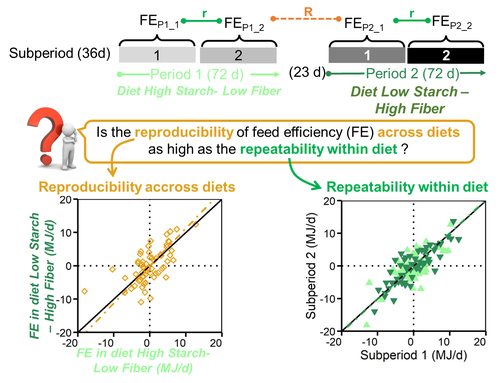
Feed efficiency of lactating Holstein cows was not as repeatable across diets as within diet over subsequent lactation stagesAmelie Fischer, Philippe Gasnier, philippe faverdin https://doi.org/10.1101/2021.02.10.430560A focus on feed efficiency reproducibility and repeatability of dairy cows fed different diets over the lactation stage.Recommended by Alberto Atzori based on reviews by Ioannis Kaimakamis, Angela Schwarm and 2 anonymous reviewersThe topic of feed efficiency is under discussion in the scientific community and several studies pointed out that lactation stage has to be accounted for when estimates of feed efficiency are carried out, especially for genetic ranking of animals and their performances, as highlighted by Li et al. (2017). Other researchers applied a latin square design to test dietary effects across lactation (Ipharraguerre et al. 2002) but this approach cannot be followed out of experimental conditions and particularly does not allow, nowadays, to valorize precision livestock farm data to get phenotypic information from individual animals at farm level. The current manuscript by Fischer, et al. (2022a) describes an experimental trial in which cows were first fed a high starch diet-low fibre then switched over to a low starch diet-high fibre and individually monitored over time. Data were analyzed with the objective to investigate effects within diets and across diets. Since all cows went through the same sequence at the same time it was not possible to completely separate the confounding effect of lactation stage and diet as stated by the authors. However, this manuscript adds methodological discussions and opens research questions especially to the matter of repeatability and reproducibility of feed efficiency of individual animals over the lactation stage. These variables are fundamental to evaluate nutritional traits and phenotypic performances of dairy cows at farm level, as highlighted by a paper of the same first author (Fischer, et al. 2022b) dealing to reproducibility and repeatability with a similar approach. My opinion is that this manuscript gives the opportunity to enlarge the scientific discussions on the calculation of repeatability and reproducibility of feed efficiency of individual animals over time. In particular, as in this study, specific mathematical approaches need to be carried out with the final goal to analyze and valorize precision livestock farm data for cow phenotyping and to propose new methods of feed efficiency evaluations. It also needs complete databases carried out under experimental conditions. In fact it has to be considered that this manuscript makes available to the scientific community all the data and the R code developed for data analysis giving the opportunity to replicate the calculations and propose new advancements in the feed efficiency evaluations of dairy cows. References Fischer A, Gasnier P, Faverdin P (2022a) Feed efficiency of lactating Holstein cows was not as repeatable across diets as within diet over subsequent lactation stages. bioRxiv, 2021.02.10.430560, ver. 3 peer-reviewed and recommended by Peer Community in Animal Science. https://doi.org/10.1101/2021.02.10.430560 Fischer A, Dai X, Kalscheur KF (2022b) Feed efficiency of lactating Holstein cows is repeatable within diet but less reproducible when changing dietary starch and forage concentrations. animal, 16, 100599. https://doi.org/10.1016/J.ANIMAL.2022.100599 Ipharraguerre IR, Ipharraguerre RR, Clark JH (2002) Performance of Lactating Dairy Cows Fed Varying Amounts of Soyhulls as a Replacement for Corn Grain. Journal of Dairy Science, 85, 2905–2912. https://doi.org/10.3168/JDS.S0022-0302(02)74378-6 Li B, Berglund B, Fikse WF, Lassen J, Lidauer MH, Mäntysaari P, Løvendahl P (2017) Neglect of lactation stage leads to naive assessment of residual feed intake in dairy cattle. Journal of Dairy Science, 100, 9076–9084. https://doi.org/10.3168/JDS.2017-12775
| Feed efficiency of lactating Holstein cows was not as repeatable across diets as within diet over subsequent lactation stages | Amelie Fischer, Philippe Gasnier, philippe faverdin | <p>Background: Improving feed efficiency has become a common target for dairy farmers to<br>meet the requirement of producing more milk with fewer resources. To improve feed<br>efficiency, a prerequisite is to ensure that the cows identified as mo... |  | Cattle production, Ruminant nutrition | Alberto Atzori | Anonymous, Ioannis Kaimakamis, Giuseppe Conte, Angela Schwarm | 2021-02-11 08:43:59 | View |
24 May 2024
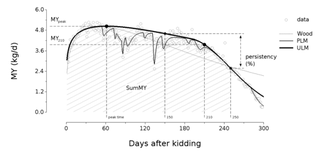
Diversity of performance patterns in dairy goats: multi-scale analysis of the lactation curves of milk yield, body condition score and body weightNicolas Gafsi, Olivier Martin, Fabrice Bidan, Bénédicte Grimard, Laurence Puillet https://doi.org/10.5281/zenodo.10101318Understanding milk and body reserves trajectories and nutrient partitioning in dairy goats through a modelling approachRecommended by Alberto Atzori based on reviews by Kristan Reed and 2 anonymous reviewersThe dairy sector is facing an historical period of high milk demand. However, increasing feed prices continually reduces the economic margins for farms. Managerial strategies to increase economical and technical awareness of animal performance, support the decision chain and optimize the use of production inputs are increasingly necessary, especially in goat farms with intensive production systems. Among the scientific goals, there is a particular emphasis on increasing knowledge about nutrition partitioning between milk production and body reserves — a topic that not easily addressed by nutritional models, limiting the attempts at production forecasting. The paper by Gafsi et al (2024) presents an interesting approach to studying phenotypic traits and trajectories of goat performance. It assesses the diversity of phenotypic trajectories reflecting functions such as milk production, body weight and condition score. This approaches aims to describe, understand and explore the interactions among biological functions and potential trade-offs of phenotypic trajectories across current and successive lactations. The work significantly contributes to the literature, particularly because previous descriptions of lactation curves relied primarily on mathematical outputs lacking information about the relationship among physiologically related variables. The analysis retrieved data from about 1500 goats over more than 20 years and was conducted with a multiscale approach. Data were fitted considering different types of models, including description of perturbations for lactation curves and with multiphasic models for the body weight and body condition score. Synthetic indicators were then estimated with a multivariate approach to define fitted trajectories and changes in performance.
Reference Gafsi N, Martin O, Bidan F, Grimard B, Puillet L (2024) Diversity of performance patterns in dairy goats: multi-scale analysis of the lactation curves of milk yield, body condition score and body weight. Zenodo. 10101318. ver.3 peer-reviewed and recommended by Peer Community In Animal Science. https://doi.org/10.5281/zenodo.10101318
| Diversity of performance patterns in dairy goats: multi-scale analysis of the lactation curves of milk yield, body condition score and body weight | Nicolas Gafsi, Olivier Martin, Fabrice Bidan, Bénédicte Grimard, Laurence Puillet | <p style="text-align: justify;">In the dairy goat sector, reduced longevity is a key issue leading to higher replacement rates in the herd and a poor dilution of doe rearing costs. There is a need to better understand the determinants of lifetime ... |  | Animal nutrition modelling, Lactation biology , Mathematical modelling, Physiology, Precision livestock farming, Small ruminants | Alberto Atzori | 2023-11-10 12:20:20 | View | |
06 Sep 2023
Validation of a Radio frequency identification system for tracking location of laying hens in a quasi-commercial aviary systemSabine G. Gebhardt-Henrich, Alexander Kashev, Matthew B. Petelle, Michael J. Toscano https://doi.org/10.1101/2023.02.16.528820Tracking large numbers of hens in aviary housing: validation of a Radio Frequency Identification systemRecommended by Anna Olsson based on reviews by Arjen van Putten and Mona Giersberg based on reviews by Arjen van Putten and Mona Giersberg
With the increasing use of cage-free housing systems for laying hens comes the challenge of monitoring the behaviour of individual hens in large enclosures where they can be not only on the floors but on different levels. The aim of the present study by Gebhardt-Henrich et al., (2023) was to validate a Radio Frequency Identification (RFID) system with the capacity to track a large number of hens for different research and applied purposes where behaviour monitoring is relevant, such as heritability estimates for breeding programs. In a housing system with 225 birds per pens, 26 antennae were placed at different locations. All birds in 5 pens were equipped with a glass tag in a custom-developed leg band. For validation purposes, the behaviour of three hens who could move between two pens was also monitored on video. Equipping these hens with colour-coded backpacks made them identifiable on video. Matching the antennae detection of the focal birds with the behaviour observation showed that the antennae were able to detect a hen on the right tier in > 90% of cases, but that match on antenna level was lower. The limitations of the system are also discussed in this concise methods paper that will be helpful to many researchers interested in tracking laying hens in loose housing systems. Gebhardt-Henrich, S.G., Kashev, A., Petelle, M.B., Toscano, M.J., 2023. Validation of a Radio frequency identification system for tracking location of laying hens in a quasi-commercial aviary system. bioRxiv 2023.02.16.528820. ver. 3 peer-reviewed and recommended by Peer Community in Animal Science. https://doi.org/10.1101/2023.02.16.528820
| Validation of a Radio frequency identification system for tracking location of laying hens in a quasi-commercial aviary system | Sabine G. Gebhardt-Henrich, Alexander Kashev, Matthew B. Petelle, Michael J. Toscano | <p>Cage-free housing is increasingly chosen in Europe, North America, and Australia as an animal-welfare friendly farm system for laying hens. However, hens are kept in large numbers in those systems which makes checking for health and welfare dif... | Animal genetics, Animal welfare | Anna Olsson | 2023-02-17 08:54:51 | View | ||
06 Feb 2025
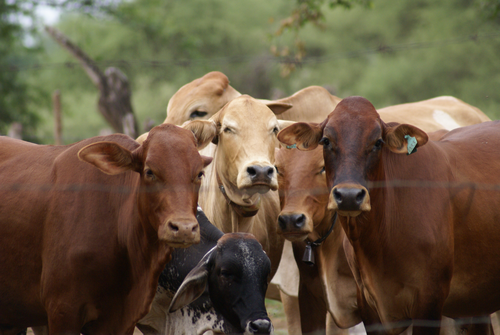
Preferred livestock interventions for small-scale farmers in the Great Limpopo Transfrontier Conservation Area: a demand-driven and participatory approachVimbai Gobvu, Sharai Ncube, Venancio E. Imbayarwo-Chikosi, Robin Bourgeois, Prisca H. Mugabe, Alexandre Caron https://hal.science/hal-04060712What kind of livestock interventions are relevant for small-scale farmers in Great Limpopo Transfrontier Conservation Area?Recommended by Anna Olsson based on reviews by 2 anonymous reviewers based on reviews by 2 anonymous reviewers
The predominant form of agriculture in sub-Saharan Africa is mixed crop and livestock production, typically in extensive systems characterised by low productivity and little input (Tui et al., 2021). Such extensive systems experience many challenges, including access to rangeland and other sources of livestock feed, loss of soil quality, increasingly unpredictable climate but also operational constraints such as access to markets and veterinary care. The work by Gobvu and collaborators (2025) addresses livestock farming sustainability specifically in the context of a Transfrontier Conservation Area (TFCA). A TFCA is defined as part of an ecological region reaching across boundaries of two or more countries and in which there are protected areas as well as resource use areas. TFCAs are founded to facilitate collective management of resources for the benefit of biodiversity as well as socio-economic development (SADC, 2025). Livestock farming in TFCAs face additional challenges arising from the tension between biodiversity protection and resource use, such as wildlife predation on livestock, competition between livestock and wildlife for feed and water as well as spread of infections between livestock and wild animals (Matseketsa et al., 2019; Caron et al., 2013; Cumming, 2011). The paper reports a study that was part of a larger project (EU-ProSuLi project, Caron et al., 2022) aiming at promoting local development and well-being of residents in the Great Limpopo TFCA, with focus on the Sengwe Communal Area in Zimbabwe. The specific aim was to test a methodology for identifying interventions that are aligned with the needs of the local stakeholders (demand-driven interventions. Anticipatory scenario building in the context of workshops was used in combination with individual questionnaires. Community representatives (n=31) were purposefully selected for their expected ability to act as knowledge brokers. A team of 10 facilitators supported the discussion through plenary and group work sessions. The participants were asked to identify factors of change with impact on local community livelihood, and subsequently to vote to select the most influential factors. Different future states for the year 2038, resulting from the impact of the factors of change, were discussed. In a follow-up workshop, participants were asked to propose activities that would support the development towards the most desirable scenario. In addition, a questionnaire was distributed through semi-structured/structured interviews to 126 households in nine villages. Results were largely similar and complementary between the two approaches. Preferred interventions were: restocking herds with locally adapted breeds, training in livestock management, marketing support, feed development and value addition, loan schemes for investment in livestock production and support for animal health interventions to reduce the heavy disease burden. Whereas the participatory process is time consuming and requires considerable human resources, it is important to ensure locally relevant interventions are chosen, and it is in itself part of the process towards successful implementation of these interventions. The study is thoughtfully designed based on previous work by the authors. The paper is well written and has been further improved through the reviewer feedback and revision process. References Caron, A., Miguel, E., Gomo, C., Makaya, P., Pfukenyi, D.M., Foggin, C., Hove, T. and de Garine-Wichatitsky, M., 2013. Relationship between burden of infection in ungulate populations and wildlife/livestock interfaces. Epidemiology & Infection, 141 (7), pp.1522-1535. https://doi.org/10.1017/S0950268813000204 Caron, A., Mugabe, P., Bourgeois, R., Delay, E., Bitu, F., Ducrot, R., Fafetine, J., Fynn, R., Guerbois, C., Motsholapheko, M. and Daré, W., 2022. Social-ecological System Health in Transfrontier Conservation Areas to Promote the Coexistence Between People and Nature. One Health Cases. https://doi.org/10.1079/onehealthcases.2022.0005 Cumming, D. H. M. 2011. Constraints to conservation and development success at the wildlife-livestock-human interface in southern African transfrontier conservation areas: a preliminary review. Wildlife Conservation Society, New York. http://www.wcs-ahead.org/workinggrps_kaza.html Gobvu, V. Ncube, S. Imbayarwo-Chikosi, V.E., Bourgeois, R. Mugabe, P.H. and Caron A. 2025. Preferred livestock interventions for small-scale farmers in the Great Limpopo Transfrontier Conservation Area: a demand-driven and participatory approach. HAL, ver.5 peer-reviewed and recommended by PCI Animal Science. https://hal.science/hal-04060712 Matseketsa, G., Muboko, N., Gandiwa, E., Kombora, D.M. and Chibememe, G., 2019. An assessment of human-wildlife conflicts in local communities bordering the western part of Save Valley Conservancy, Zimbabwe. Global Ecology and Conservation, 20, p.e00737. https://doi.org/10.1016/j.gecco.2019.e00737 Tui, S.H.K., Descheemaeker, K., Valdivia, R.O., Masikati, P., Sisito, G., Moyo, E.N., Crespo, O., Ruane, A.C. and Rosenzweig, C., 2021. Climate change impacts and adaptation for dryland farming systems in Zimbabwe: a stakeholder-driven integrated multi-model assessment. Climatic Change, 168 (1-2), p.10. https://doi.org/10.1007/s10584-021-03151-8 South African Development Community. 2025. Transfrontier Conservation Areas. . Consulted 7 January 2025. https://www.sadc.int/pillars/transfrontier-conservation-areas
| Preferred livestock interventions for small-scale farmers in the Great Limpopo Transfrontier Conservation Area: a demand-driven and participatory approach | Vimbai Gobvu, Sharai Ncube, Venancio E. Imbayarwo-Chikosi, Robin Bourgeois, Prisca H. Mugabe, Alexandre Caron | <p>In southern Africa, residents of Transfrontier Conservation Areas (TFCAs), devoted to biodiversity conservation and local development and well-being, practice small-scale farming in semi-arid environments constrained by the presence of pr... |  | Agricultural sustainability, Cattle production | Anna Olsson | 2023-04-06 12:54:58 | View | |
28 Jan 2022
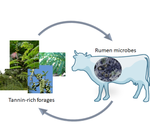
Microbial colonization of tannin-rich tropical plants: interplay between degradability, methane production and tannin disappearance in the rumenMoufida Rira, Diego P Morgavi, Milka Popova, Gaelle Maxin, Michel Doreau https://doi.org/10.1101/2021.08.12.456105Ruminal microbial degradation of tannin-rich tropical plants and methane productionRecommended by Antonio Faciola based on reviews by Todd Callaway and Srinivasan MahalingamRira et al. (2022) evaluated ruminal degradation of tropical tannins-rich plants and the relationship between condensed tannins disappearance and microbial communities. I found this study relevant because a major limitation for tropical plants utilization by ruminants is their potential reduced nutrient digestion. In this study, authors used leaves from Calliandra calothyrsus, Gliricidia sepium, and Leucaena leucocephala, pods from Acacia nilotica and the leaves of Manihot esculenta and Musa spp., which were incubated in situ in the rumen of dairy cows. An in vitro approach was also used to assess the effects of these plants on ruminal fermentation. They observed that hydrolysable and free condensed tannins from all plants completely disappeared after 24 h incubation in the rumen. Disappearance of protein-bound condensed tannins was variable with values ranging from 93% for Gliricidia sepium to 21% for Acacia nilolitica. This demonstrated some potential for selection and improvements in protein digestion. In contrast, fibre-bound condensed tannins disappearance averaged ~82% and did not vary between plants, which was remarkable. The authors noted that disappearance of bound fractions of condensed tannins was not associated with degradability of plant fractions and that the presence of tannins interfered with the microbial colonisation of plants. Each plant had distinct bacterial and archaeal communities after 3 and 12 h of incubation in the rumen and distinct protozoal communities at 3 h. This suggests a great deal of specificity for microbial-plant interactions, which warrants further evaluation to consider also animal contributions to such specificity. Adherent communities in tannin-rich plants had a lower relative abundance of fibrolytic microbes, notably Fibrobacter spp. Whereas, archaea diversity was reduced in high tannin-containing Calliandra calothyrsus and Acacia nilotica at 12 h of incubation. Concurrently, in vitro methane production was lower for Calliandra calothyrsus, Acacia nilotica and Leucaena leucocephala although for the latter total volatile fatty acids production was not affected and was similar to control. Finally, the study demonstrated that the total amount of hydrolysable and condensed tannins contained in a plant play a role governing the interaction with rumen microbes affecting degradability and fermentation. The effect of protein- and fibre-bound condensed tannins on degradability is less important. The major limitation of the study is the lack of animal validation at this stage; therefore, further studies are warranted, especially studies evaluating these plants in vivo. Furthermore, mechanisms associated with plant-microbial specificity, the role played by the host, and more data on nutrient utilization and gas production should be investigated. Nonetheless, this work show interesting microbial colonization and specific plant-microbial relationships that are novel in the ruminal environment. Reference: Rira M, Morgavi DP, Popova M, Maxin G, Doreau M (2022). Microbial colonization of tannin-rich tropical plants: interplay between degradability, methane production and tannin disappearance in the rumen. bioRxiv, 2021.08.12.456105, ver. 3 peer-reviewed and recommended by Peer Community in Animal Science. https://doi.org/10.1101/2021.08.12.456105
| Microbial colonization of tannin-rich tropical plants: interplay between degradability, methane production and tannin disappearance in the rumen | Moufida Rira, Diego P Morgavi, Milka Popova, Gaelle Maxin, Michel Doreau | <p>Condensed tannins in plants are found free and attached to protein and fibre but it is not<br>known whether these fractions influence rumen degradation and microbial colonization.<br>This study explored the rumen degradation of tropical tannins... |  | Animal nutrition modelling, Cattle production, Emissions , Farming systems, Gut microbiology, Microbial ecology, Microbial fermentation, Rumen microbiology, Rumen microbiome , Ruminant nutrition | Antonio Faciola | 2021-08-16 08:56:45 | View | |
07 Feb 2022
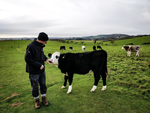
Resilience: reference measures based on longer-term consequences are needed to unlock the potential of precision livestock farming technologies for quantifying this traitFriggens, N. C., Adriaens, I., Boré, R., Cozzi, G., Jurquet, J., Kamphuis, C., Leiber, F., Lora, I., Sakowski, T., Statham, J. and De Haas, Y. https://doi.org/10.5281/zenodo.5215797Measuring resilience in farm animals: theoretical considerations and application to dairy cowsRecommended by Aurélien Madouasse based on reviews by Ian Colditz and 2 anonymous reviewers based on reviews by Ian Colditz and 2 anonymous reviewers
Farm animals differ in their ability to respond to the many environmental challenges they face. Such challenges include infectious diseases, metabolic diseases resulting from inadequate coverage of dietary needs, as well as the diverse consequences of climate change. Various concepts exist to characterise the responses of animals to different types of challenges. This article by Friggens et al. (2022) focuses on resilience, providing a conceptual definition and proposing a method to quantify resilience in dairy cows. The first part of the paper provides a definition of resilience and highlights its differences and relations with the related concepts of robustness, and, to a lesser extent, resistance and tolerance. In essence, resilience is the ability of an animal to bounce back quickly after a challenge of limited duration. On the other hand, robustness is the ability of an animal to cope with conditions that are overall unfavourable. From these conceptual and intuitive definitions, there are several difficulties precluding the design of concrete methods to measure resilience. First, there is some degree of overlap between the concepts of resilience, robustness, resistance and tolerance. Secondly, resilience is a multidimensional concept whereby resilience to a given perturbation does not imply resilience to other types of perturbation, e.g. resilience to a challenge by a specific pathogen does not imply resilience to a nutritional challenge. A further difficulty in the measure of resilience is the fact that different animals may be exposed to challenges that are different in nature and in number. The authors argue that although resilience cannot be measured directly (it should be seen as a latent construct), it is possible to quantify it indirectly through its consequences. In the second part of the paper, the authors propose a method to quantify resilience of individual dairy cows. The method is based on the premise that resilient animals should be kept longer in their herd than non-resilient animals. The main criterion in the evaluation is therefore the ability of cows to re-calve. Each cow that is calving receives a certain number of points, to which, in each lactation, bonus points are added for higher milk production and penalty points are removed for each insemination after the first one, for each disease event and for each day of calving interval above some herd specific value. Therefore, cows have a resilience score in each lactation. They also have a lifetime resilience score obtained by summing the scores for all the lactations, that gets bigger as the cow has more calves, and that also takes the age at first calving into account. In a previous study, Adriaens et al. (2020) showed that higher resilience scores were associated with fewer drops in milk yield and more stable activity dynamics. Starting from theoretical considerations on the notion of resilience, this paper describes a concrete method to quantify animal-level resilience on farm. Such quantification will be useful for breeding and culling decisions. Finally, the general framework to design resilience measures that is presented will be useful to researchers working on the quantification of farm animal resilience using new methods and data sources.
References Adriaens I, Friggens NC, Ouweltjes W, Scott H, Aernouts B and Statham J 2020. Productive life span and resilience rank can be predicted from on-farm first-parity sensor time series but not using a common equation, across farms. Journal of Dairy Science 103, 7155-7171.https://doi.org/10.3168/jds.2019-17826 Friggens, N.C. , Adriaens, I., Boré, R., Cozzi, G., Jurquet, J., Kamphuis, C., Leiber, F., Lora, I., Sakowski, T., Statham, J., De Haas, Y. (2022). Resilience: reference measures based on longer-term consequences are needed to unlock the potential of precision livestock farming technologies for quantifying this trait. Zenodo, 5215797, ver. 5 peer-reviewed and recommended by Peer community in Animal Science. https://dx.doi.org/10.5281/zenodo.5215797 | Resilience: reference measures based on longer-term consequences are needed to unlock the potential of precision livestock farming technologies for quantifying this trait | Friggens, N. C., Adriaens, I., Boré, R., Cozzi, G., Jurquet, J., Kamphuis, C., Leiber, F., Lora, I., Sakowski, T., Statham, J. and De Haas, Y. | <p style="text-align: justify;">Climate change, with its increasing frequency of environmental disturbances puts pressures on the livestock sector. To deal with these pressures, more complex traits such as resilience must be considered in our mana... |  | Precision livestock farming | Aurélien Madouasse | 2021-08-20 15:34:13 | View | |
13 Mar 2025
Shade use, welfare and performance of ewes grazing in temperate silvopastures differing in tree densityCécile Ginane, Mickaël Bernard, Véronique Deiss, Donato Andueza, Camille Béral https://doi.org/10.5281/zenodo.10974491Provision of optimal shade for ewes: a question of choiceRecommended by Birte L Nielsen based on reviews by Matteo Chincarini and Pol Llonch based on reviews by Matteo Chincarini and Pol Llonch
As the world slowly (or not so slowly) warms, the ability to regulate heat becomes even more pertinent for livestock kept in enclosed areas. Trees are not always present on land grazed by sheep, and when the pasture has some forestation, the coverage will provide varying degrees of shade. In this study by Ginane et al. (2025), ewes kept in enclosures with different levels of tree cover were observed at different times over a period of three years to investigate the extent to which the animals chose to spend time in the shade. By using fields with very different provision of shade (approximately 1, 40, and 81% shade, respectively), the authors wanted to test the hypothesis that ewes would actively seek out tree shade when the combined temperature and humidity increased – especially if the conditions reached levels associated with heat stress. Even at the lowest provision of shade, which consisted of a single tree in the paddock, all ewes could fit within the shade cast by the tree; but if the distribution of ewes or groups of ewes were random, i.e. independent of shade, the likelihood of these ewes being in the shade by chance was effectively 1%. By factoring in the element of chance, the authors found that mean shade use was greater than the tree canopy cover for the low and medium shade treatments, whereas it didn’t differ from chance for the densely forested treatment. Across treatments, all ewes spent just under 60% of the observation time grazing, and the ewes with the low and medium level of shade actively selected shade for foraging activity, whereas the ewes with over 80% canopy cover avoided it. Across treatments, shade was used primarily for resting and ruminating. Tree cover affected the availability of forage in a negative manner, with more biomass available for ewes in the low shade treatment and significantly less in the high treatment, although this did not translate into significant differences in live weight or body condition score. Using this information, Ginane et al. (2025) calculated the optimal level of tree cover to be somewhere between the low and medium cover, at roughly 30 trees per hectare – preferably spread out over the area to offer different locations of shade and to encourage a natural spread of manure. This longitudinal study of shade use by ewes provides novel and useful information on the positive and negative effects of tree cover in paddocks used to rear ewes with lambs. The authors raise the limitation of the study themselves, and they would have liked to also include observations on non-sunny days, to be able to eliminate place preferences independently of shade availability. But the clever calculation of active shade-selection makes this study easily applicable for use in the assessment of paddock suitability for pregnant ewes. References Cécile Ginane, Mickaël Bernard, Véronique Deiss, Donato Andueza, Camille Béral (2025) Shade use, welfare and performance of ewes grazing in temperate silvopastures differing in tree density. Zenodo, ver.4 peer-reviewed and recommended by PCI Animal Science https://doi.org/10.5281/zenodo.15001481 | Shade use, welfare and performance of ewes grazing in temperate silvopastures differing in tree density | Cécile Ginane, Mickaël Bernard, Véronique Deiss, Donato Andueza, Camille Béral | <p>The study aimed to objectify the importance of trees for sheep welfare by characterising how productive ewes, grazing in temperate mid-mountain pastures, use shade depending on climatic conditions and tree density. The impact of trees on sheep ... | Animal behaviour , Animal welfare, Grazing management , Small ruminants | Birte L Nielsen | 2024-04-03 11:39:54 | View | ||
01 Sep 2022
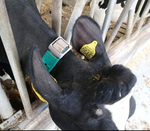
Detecting dairy cows' lying behaviour using noisy 3D ultrawide band positioning dataI. Adriaens, W. Ouweltjes, M. Pastell, E. Ellen, C. Kamphuis https://doi.org/10.5281/zenodo.6627251A novel method to monitor lying behaviour of dairy cows by combining noisy spatial positioning data, time-series segmentation based on statistical changepoints and machine learning classification algorithmRecommended by Eliel Gonzalez-Garcia based on reviews by Kareemah Chopra and John Fredy Ramirez AgudeloUsing on-farm sensors in dairy farming is known to help decision makings and farmer objectives in the monitoring and potential improvement of animal behaviour, health and production performance. However, in indoor positioning systems, data interpretation is complicated by the inaccuracy and noise in the time series, missing data caused not only by sensor failure or the harsh and changing farm environments in which they operate, but also by the animals' specific physiology itself. Thus, working with spatial data has proven challenging mainly due to their enormous heteroscedasticity, which depends on multiple factors such as the cow, the time of the day, the behaviour, factors interfering with the sensor system, etc., for which we cannot account mathematically. Applying purely black-box approaches generally results in insufficient robustness, interpretability and generalisability. With this work, Adriaens et al. (2022) developed a relatively simple and new methodology to monitor the lying behaviour of dairy cows by using noisy spatial positioning data, while combining time-series segmentation based on statistical changepoints and a machine learning classification algorithm. The two-step methodology identifies lying behaviour using an ultra-wide band indoor positioning system. Getting-up or lying-down events were indicated by the accelerometers. Overall classification and lying behaviour prediction performance was above 91% in independent test sets, with a very high consistency across cow-days. The robustness of the algorithm was demonstrated by the fact that both the cow identity-based split and the time-based split performed equally well. The article represents an original contribution for advancing the state of the art in the automated quantification of lying behaviour in dairy cows, aiming to monitor health or animal welfare issues. Future research must be considered however to validate the performance of the model when using different position-measuring technologies, in other farm settings and over a longer period of time.
Reference Adriaens I, Ouweltjes W, Pastell M, Ellen E, Kamphuis C. 2022. Detecting dairy cows' lying behaviour using noisy 3D ultra-wide band positioning data. Zenodo, 6627251, ver. 3 peer-reviewed and recommended by Peer Community in Animal Science. https://doi.org/10.5281/zenodo.6627251
| Detecting dairy cows' lying behaviour using noisy 3D ultrawide band positioning data | I. Adriaens, W. Ouweltjes, M. Pastell, E. Ellen, C. Kamphuis | <p>In precision livestock farming, technology-based solutions are used to monitor and manage<br>livestock and support decisions based on on-farm available data. In this study, we developed<br>a methodology to monitor the lying behaviour of dairy c... |  | Animal behaviour , Mathematical modelling, Precision livestock farming | Eliel Gonzalez-Garcia | 2022-02-28 18:19:37 | View | |
15 Dec 2020
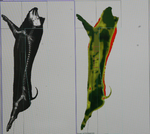
Accuracy of predicting chemical body composition of growing pigs using dual-energy X-ray absorptiometryClaudia Kasper, Patrick Schlegel, Isabel Ruiz-Ascacibar, Peter Stoll, Giuseppe Bee https://doi.org/10.1101/2020.09.15.286153Accurate predictions of chemical composition of pigs for a wide range of body weights: no longer a myth!Recommended by Florence Gondret based on reviews by Mathieu Monziols and 1 anonymous reviewerAssessing body or carcass composition in growing pigs is essential to refine nutritional models, select for specific traits and evaluate pork products. The gold standard methods are dissection and chemical measurements, which are time-consuming and invasive ways to obtain the data. Different teams have tested dual-energy x-ray absorptiometry (DEXA), especially for determining total and regional body composition of fat, soft lean tissues and bone minerals [1-3]. The DEXA measurements are quick, non-invasive, precise, and operator independent. However, the instruments from different manufacturers are unique in implementation so that it is difficult to obtain and share generalized equations. In addition, the validity and accuracy of the measures when applied to pigs having very different composition have been scarcely addressed.
The present manuscript shows that carcass analysis by DEXA can be used to predict empty body chemical composition, and it provides accuracy values for the content in single nutrients (protein, lipids, Ca, P). The body weight range used to generate differences in body composition is very large (20 to 100 kg), which is important when studying pigs along growth. Moreover, regression equations within weight classes (20, 60 and 100 kg) show no important biases, with the exception for body fat especially at the earliest growth stages. Limitations of the technique are the needs of anesthesia when applied to living pigs, and of standardizing the positions of body, carcass and cuts when applied to living or dissected pigs. Another originality of the manuscript is the comparison of the obtained calibrations with previously published prediction models, showing that the differences do not preclude the possibility to use a single model when built from a meta-analysis of the different data. Taken together, this work offers good perspectives to refine nutritional models by inputs from rapidly analyzed body chemical composition and to monitor body and carcass composition in several pigs for genetics applications.
References [1] Mitchell AD., Scholz AM., Pursel VG., and Evock-Clover CM. (1998). Composition analysis of pork carcasses by dual-energy x-ray absorptiometry. Journal of Animal Science. 76(8), 2104-14. https://doi.org/10.2527/1998.7682104x [2] Marcoux M., Bernier JF., and Pomar C. (2003). Estimation of Canadian and European lean yields and composition of pig carcasses by dual-energy X-ray absorptiometry. Meat Science. 63(3), 359-65. https://doi.org/10.1016/S0309-1740(02)00094-3 [3] Kipper M., Marcoux M., Andretta I., and Pomar C. (2018). Repeatability and reproducibility of measurements obtained by dual-energy X-ray absorptiometry on pig carcasses. Journal of Animal Science, 96(5), 2027-2037. https://doi.org/10.1093/jas/skx046 " | Accuracy of predicting chemical body composition of growing pigs using dual-energy X-ray absorptiometry | Claudia Kasper, Patrick Schlegel, Isabel Ruiz-Ascacibar, Peter Stoll, Giuseppe Bee | <p>Studies in animal science assessing nutrient and energy efficiency or determining nutrient requirements necessitate gathering exact measurements of body composition or body nutrient contents. Wet chemical analysis methods or standardized dissec... |  | Agricultural sustainability, Animal nutrition modelling, Monogastrics, Physiology, Pig nutrition | Florence Gondret | 2020-09-17 10:44:58 | View | |
10 Aug 2022
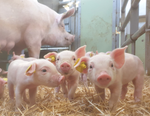
Decreasing the level of hemicelluloses in sow's lactation diet affects the milk composition and post-weaning performance of low birthweight piglets.Francesco Palumbo, Giuseppe Bee, Paolo Trevisi, Marion Girard https://doi.org/10.31220/agriRxiv.2022.00116Varying the hemicellulose content in the diet of lactating sows highlights the importance of early-life interventions for improving health and performance of small piglets during the post-weaning periodRecommended by Florence Gondret based on reviews by Hélène Quesnel and Myriam GrundyOne of the key questions in pig industry nowadays is how health and performance of piglets can be improved by sow nutrition and milk composition. The levels of dietary fibers in sow’s gestation diet have positive effects observed on the litters. However, the composition of dietary fibers and the organization of polysaccharides within the cell wall in the different plants determine their physicochemical properties and, thereby, their behaviour in the gut of the sows and the subsequent physiological response of the animals. Hemicelluloses are polysaccharides constituents of the cell walls of plants, which are fermented in the gut to produce volatile fatty acids (VFA). These VFA can serve as energy source for milk synthesis and can thereby influence the development of suckling piglets. Palumbo and colleagues (1) proposed an original experimental design to compare diets with similar fiber contents but different hemicellulose levels, thanks to varying the sources of fibers used in the dietary formulations. Effects were studied on performance and health of lactating sows and their piglets during suckling period and until post-weaning. The dietary treatments had no effect on the total number of piglets weaned and, consequently, on litter weight at weaning. Milk yield was not influenced by the dietary treatments, but milk composition (lactose content, copper and threonine proportions) was affected by the level of hemicellulose in the maternal diets. With a decreasing hemicellulose level in sow diet, milk lactose content linearly decreased, whereas the copper and threonine contents linearly increased. There was no effect on piglet performance during the lactation period. During the second week of post-weaning, a quadratic increase in the incidence of diarrhoea and the number of days with diarrhoea for suckling piglets was observed with decreasing hemicellulose level in diet. Interestingly, the observed effects were partly different for piglets born with a low body weight. Indeed, there was a linear decrease in the incidence of diarrhoea and days with diarrhoea with decreased hemicellulose level in the maternal diet for those piglets, together with increased growth performance from birth to two weeks post-weaning. The authors postulated that the improved growth performance and the lower incidence of diarrhoea observed in small piglets during post-weaning period may be related to the increased abundance of threonine and copper and increased concentration of total VFA in milk of sows fed a diet with reduced hemicellulose levels. This study confirms the importance of early-life interventions to improve the post-weaning development and health of this sub-population of piglets. Reference (1) Palumbo F, Bee G, Trevisi P, and Girard M. (2022). Decreasing the level of hemicelluloses in sow's lactation diet affects the milk composition and post-weaning performance of low birthweight piglets. agriRxiv 2022.00116, ver 4 (R3), peer-reviewed and recommended by PCI Animal Science. https://doi.org/10.31220/agriRxiv.2022.00116 | Decreasing the level of hemicelluloses in sow's lactation diet affects the milk composition and post-weaning performance of low birthweight piglets. | Francesco Palumbo, Giuseppe Bee, Paolo Trevisi, Marion Girard | <p>Hemicelluloses (HC) are polysaccharides constituents of the cell walls of plants. They are fermented in the gut to produce volatile fatty acids (VFA). The present study investigated the effects of decreasing HC level in sow's lactation diet on ... |  | Pig nutrition | Florence Gondret | 2022-01-21 12:00:22 | View |
FOLLOW US
MANAGING BOARD
Karol B Barragán-Fonseca
Mohammed Gagaoua
Rachel Gervais
Florence Gondret
Francois Meurens
Rafael Muñoz-Tamayo*
Christian Nawroth
Seyed Abbas Rafat
Yuliaxis Ramayo-Caldas
* Representative









